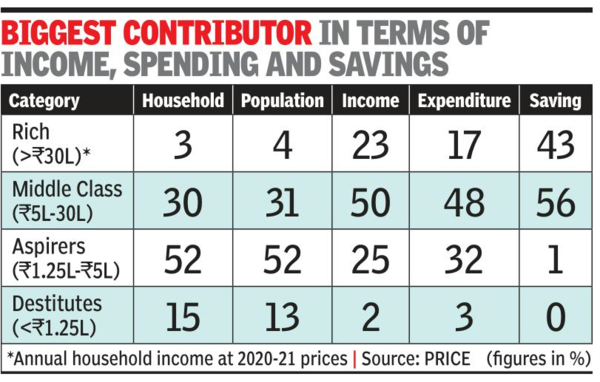Middle class nearly 1/3rd of India’s population, to be 2/3rds by 2047: Report – Times of India
“By 2047, if political and economic reforms have their desired effect, the India income pyramid will have a smallish layer at the bottom comprising the destitute and aspirer groups, a huge bulge of the middle class and a big creamy ‘rich’ layer on top,” says Rajesh Shukla, MD and CEO of PRICE and author of the report titled: “The Rise of India’s Middle Class”. In 2021, the middle class accounted for 31%, which is expected to expand sharply in the years ahead.
Shukla says that while much has been written on this class, defining this enigmatic “middle” has always been problematic for both academicians and marketers. Lack of a universally acceptable definition, coupled with the well-known problems associated with survey data have resulted in varying estimates of its numerical estimates, says the economist who has been closely tracking the issue.

“Given that estimates range from 50 to 400 million, many question their actual strength and thus the purchasing power of this category,” he says. The report has broadly clubbed these groups into seven categories, ranging from the “destitutes” (those with an annual family income of under Rs 1,25,000 or $1,700 in 2020-21) to the “super rich” (annual family income of over Rs 2 crore or $270,000 in 2020-21) with the middle class (annual household income of between Rs 5 lakh and Rs 30 lakh or $6,700-$40,000) in between.
“The reason for clubbing households like this is that distinct patterns of consumption can be observed for these categories,” says Shukla.
The survey results showed that the “destitute” household hardly buys a car. Less than five out of every 10 “aspirer” households had an automobile in 2020-21.
In the “seekers” category, with income between Rs 5 lakh and Rs 15 lakh a year, almost three out of every 10 households have a car. In the “rich”, or those with an annual household income of over Rs 30 lakh, every household owns a car. In the category of “crorepatis”, there are almost three cars per family. Similarly, in the case of air-conditioners, while the “destitute” households have none, “aspirers” two out of every 100 and about half of the “super rich” have ACs, according to the survey.
The report, based on pan-India surveys, provides an overview of the country’s income demographics by states, urban and rural areas, and geographical clusters within each of the eight income categories. It also details the rise of the cities and India’s richer classes and explains how these cities are home to a growing number of rich Indians. It also covers the rise of 63 cities that have a population of over one million each and how the concentration of the rich has jumped in the cities from 2015-16 and chronicles the change in income demographics.
The report showed that Maharashtra is the richest state with 6.4 lakh super-rich households earning over Rs. 2 crores per annum in 2021. Delhi was second with Rs 1.81 lakh households, Gujarat third with 1.41 lakh, Tamil Nadu fourth with 1.37L and Punjab fifth with 1.01 lakh households, according to the survey results.
It showed that the number of “super rich” has risen from 98,000 in 1994-95 to 1.8 million households in 2020-21. Surat and Nagpur have the highest growth in the high-income segment.
For all the latest business News Click Here

